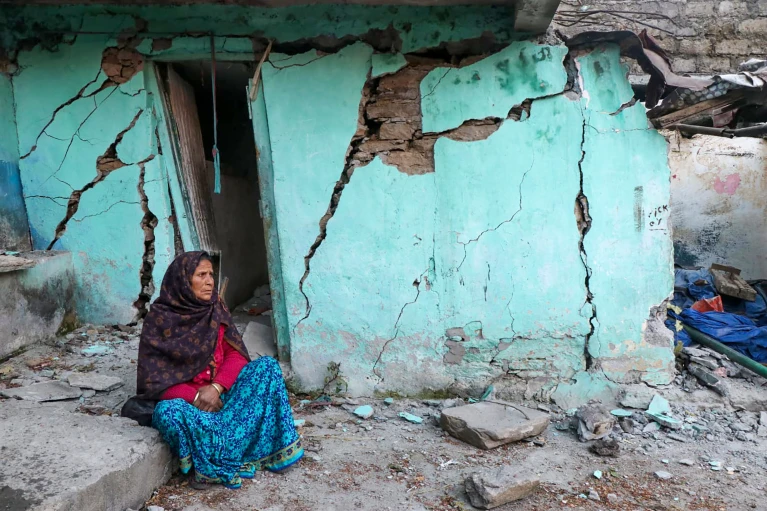
The Central Himalayan state of Uttarakhand has a long history of natural hazards, mainly attributed to changes in weather patterns, abnormal rainfall and human activities.
Vanita Srivastava
Authorities are evacuating thousands of people from their homes in Joshimath, a small settlement in Uttarakhand, India, after more than 600 houses developed cracks due to unprecedented rapid subsidence.
The Chamoli district administration has marked houses at risk with red crosses and is shifting people to temporary accommodation outside the hazardous area.
A team of scientists from the CSIR-National Geophysical Research Institute (NGRI) is assessing the situation in Joshimath, a popular town for tourists, which has a permanent population of over 16,000. The scientists are expected to report on the cause of subsidence next week.
Experts say uncontrolled infrastructure building, construction at a nearby hydroelectric station, a poor drainage system and burgeoning population in the hill town are putting pressure on its fragile landscape.
The Central Himalayan state of Uttarakhand has a long history of natural hazards, mainly attributed to changes in weather patterns, abnormal rainfall and human activities. At about 6,200 feet above sea level, Joshimath is considered a gateway to Himalayan mountain climbing expeditions and Hindu pilgrim centers. The city sits on ancient landslide deposits of sand and stone, not rock, which makes the region extremely vulnerable.
Early warnings
Warnings about subsidence came as early as 1978, when a municipal panel recommended banning major construction work in the area and observed that since the city rests on sand and stone deposits from old landslides, it was slowly “sinking”.
Mass sinking associated with soil creep and debris displacement were responsible for landslide in the Sunil area of Joshimath hill complex, according to another 1982 study1. It noted that boulders embedded in loose sandy soil were being displaced due to seepage of spring waters. This has led to local sinking.
In 2010, researchers from Garhwal University and Disaster Mitigation Management Centre also cautioned of an imminent ecological threat. “Joshimath has been showing signs of distress due to the burgeoning anthropogenic pressure,” they wrote in the journal Current Science.
Population boom, poor drainage
Geologists maintain that the present crisis unfolded because of poor planning and the failure of authorities to take notice of these repeated warnings.
“It is an utter failure of governments,” Yaspal Sundriyal, a former head of the geology department at Hemwati Nandan Bahuguna Garhwal University, told Nature India. Many scientists have warned of this impending danger but none of the ruling governments over the years have taken action, he said.
The ecological crisis in Joshimath has been triggered by human activities. “The population has increased manifold and so have infrastructure projects. The buildings are not designed taking into account the fragility of the landscape,” he said.
Sundriyal said there was no system to manage wastewater, which was pushing down lose material into the ground, resulting in the sinking.
Sushil Khandauri, a geologist at the Uttarakhand State Disaster Management Authority said some building had developed very small cracks after flash floods in Uttarakhand towards the end of 2021. “Unscientific construction and poor drainage triggered the recent subsidence,” Khandauri told Nature India.
Tunnels for a nearby hydropower project are made through blasts, which shakes up the debris above the rocks, leading to cracks in houses. “The project is hazardous for the local environment and has wreaked havoc on the area’s ecology,” said Anjal Prakash, research director and Adjunct Associate Professor at Bharti Institute of Public Policy at the Indian School of Business in Hyderabad.
“Tunnel construction activity has impacted water regimes”, Prakash, a coordinating lead author for the IPCC Special Report on the Ocean and Cryosphere in a Changing Climate (SROCC), told Nature India. Two of these special reports published in 2019 and 2022 pointed out that this Himalayan region was a climate hotspot. “Joshimath is an example of what we should not do in the Himalayas,” Prakash said.
____________________
Courtesy: Nature (Published on Jan 11, 2023)